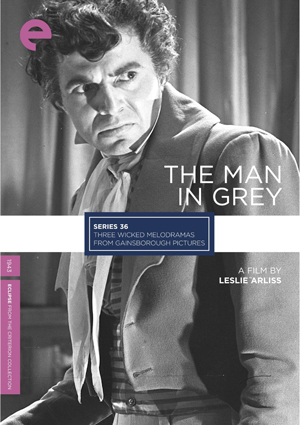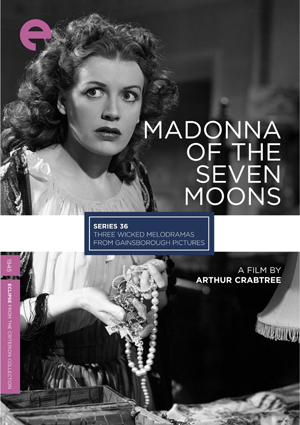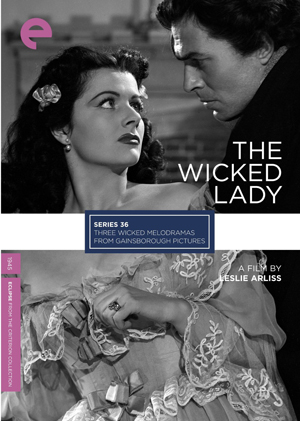
 |
|
|
|
Once again (I think I've begun an Eclipse review with those words three times now) the Eclipse series introduces us to a grouping of pictures that would otherwise have stayed far out of sight. Back in the 1940s, a faltering English company got an infusion of production funds from Rank and took a new direction toward period melodramas with decidedly non-intellectual content: ambitious young schoolgirls, cruel relatives, imperious nobility, scheming villainesses, devious highwaymen and unlucky wives stricken by odd bouts of erotic amnesia. In other words, the movies adapted to the screen the appeal of Trash Romance Novels (prime overachieving example: Forever Amber). The company, Gainsborough Pictures, took a flyer on a lusty bodice-ripper and found that they'd hit an untapped vein. Wartime Brit audiences welcomed the double-crossing, deception, forbidden lust and cruel vendettas of these pictures. Although critics turned up their noses at what was an affront to the English heritage of quality, Gainsborough somehow slipped the immoral activity, implied sexuality and low, low necklines (for 1943) through the censorship apparatus of the time. Having been excluded from the class of production deemed suitable for awards or critical acclaim, the Gainsborough pictures have been bypassed by film critics despite featuring interesting casting choices, including the debut of star James Mason. Eclipse has chosen three of the most popular for this arresting series: Three Wicked Melodramas from Gainsborough Pictures. 
A regular circus of innocence, conniving bitchery, social cruelty and oppressive marriage, 1943's The Man in Grey was a solid hit with the public. The easy-to-follow story traces the schoolgirl beginnings of Hester and Clarissa (Margaret Lockwood of The Lady Vanishes & Phyllis Calvert). The popular, poised and socially comfortable Clarissa is so sweet that the poor and bitter Hester finally gives in and accepts her as a friend. Hester is thrown out of school for running away with a man, but Clarissa refuses to disassociate herself from her friend. Not much later Clarissa finds herself married to Lord Rohan (James Mason), a notorious nobleman who hates people, has few friends and wants a wife solely to create an heir. Clarissa bears him a son. She accepts her lot in life until Hester shows up again, in a needy state. Invited to become Clarissa's companion, Hester moves in and almost immediately becomes Lord Rohan's mistress, even though he knows she's a traveling actress (which connotes low morals in general). Also entering the four-way game of hearts is Peter Rokeby (Stewart Granger), a rogue actor and general mountebank. With Hester's connivance he becomes Rohan's librarian. Hester plays a risky game. Her goal is to eliminate the still clueless Clarissa and take her place as Rohan's wife. He won't jeopardize his family's good name with a divorce. Against his better judgment, Rokeby falls genuinely in love with Clarissa. Down to her last alternative, Hester decides to solve her problem with poison. The period story is bookended at a wartime auction, where descendents of two of the characters chat about personal artifacts left by the Rohan family -- that take on great significance in the story playing out 150 years earlier. The Man in Grey is directed with precision and clarity, like an adaptation of Charles Dickens. The characters are refreshingly uncomplicated. Clarissa is virtuous, pretty and incapable of perceiving malice in her friends. Hester turns heads and seems desperate to achieve respectability, no matter who suffers along the way. Lord Rohan is a heel but his affair with Hester makes him appreciate Clarissa's qualities. Rokeby is a conman also transformed by Clarissa's goodness. These amorous foursome collide like billiard balls, shooting off sparks -- the whole show is packed with plot contrivances, but it comes to bold life. Snooty Martita Hunt runs the girls' school; we can tell that Clarissa has character when she rebels openly against the headmistress's expulsion of Hester. Lord Rohan's dialogue drips with contempt for most people he meets. Jaded and joyless, he treats Clarissa terribly. Their wedding night ends with a menacing shot of Rohan advancing on Clarissa, who sits on her wedding bed with no choice but to surrender. It's genuinely hot stuff for the era. One good reason for The Man in Grey seeing few TV appearances is that a young black servant character is played by a white child actor in blackface. The Gainsborough films were out to entertain the public, not advance a social agenda. We see immediately why James Mason would make women swoon, and both of the leading ladies are dazzlers. Phyllis Calvert has a winning smile while the raven-haired Margaret Lockwood oozes sexuality. The critics probably objected to some of the dialogue as well, which excels in racy, naughty comments from students and servants on the sidelines. This is great fun. 
Madonna of the Seven Moons (1945) is an apt title for a bizarre contemporary tale, part of which still seems to take place in the past. It's set in Italy, presumably between the wars. In an opening prologue, young country girl Maddalena is the victim of a rape. Years later, Maddalena (Phyllis Calvert) has become the pampered, somewhat nervous wife of a wealthy Northern Italian. Her conservative fears are touched off when her daughter Angela (Patricia Roc) returns from school as a liberated modern, in short-shorts and traveling with a male companion. Just as she has calmed down, Maddalena suddenly disappears. Her husband finally admits to the family doctor that she has disappeared like this twice before, for months at a time, and just as mysteriously returned, with no memory of her experiences. It turns out that Maddalena is leading a double life. When touched off by the right triggers she 'becomes' Rosanna, a lusty barmaid in a town in Southern Italy, where she's the main woman of a local criminal leader, Nino (Stewart Granger). Her personalities are like night and day. Working on a clue, Angela goes south in search of her mother, while the crooked Sandro (Peter Glenville), one of Nino's gang who has used his dancing skill to penetrate 'good' social circles, comes close to recognizing Rosanna's other identity. As the plot thickens, the 'lusty' Rosanna is weirdly affected by religious symbols and ceremonies - the holy 'counter-trigger' that can return her to her other identity. Believe it or not, this preposterous, conservative storyline works extremely well in Madonna of the Seven Moons. The attitudes toward women are dated but consistent with the reality of the time. Michael Koresky's notes mention that director-cameraman Arthur Crabtree later made a pair of noted horror films. What any devotee will quickly see is that Madonna of the Seven Moons is practically a template for the later, classic Hammer Films. Scenes are built slowly, actual violence is minimized and dramatic close-ups are used for shock cuts. At one point Rosanna sees a holy procession and we're given a startling shot of her eyes, with a large cross reflected in each iris. It's like the inverse of a pentagram in a werewolf movie. Come to think of it, Seven Moons is very similar in structure to Terence Fisher's Curse of the Werewolf. Each has a prologue in which a woman is raped, before the story skips ahead half a generation. The 'magical transformation' of a character occurs in a vaguely religious context. Rosanna's reversion to a Gypsy harlot aligns with Oliver Reed's transformation into a monster. And what do we find out, but that Hammer's greatest director Terence Fisher worked on a number of Gainsborough Pictures, and edited Madonna of the Seven Moons. The Gainsborough period style and Fisher's (classic) Hammer period style are very similar -- dynamic framing, an economy of character movement, and a direct approach to the subject matter, whether it be sex, seduction, violence or horror. 
The title that retains an audience recognition factor is 1945's The Wicked Lady, which was given a trashy, witless remake by Michael Winner. The original is a stunner that exploits a most marketable idea -- a lady highwayman. That's exactly the kind of unlikely story hook that would appeal to women looking for supermarket novels. Shunned by highbrows, this show is one of all time top British attendance titles. The main character in The Wicked Lady is dashing, daring and glamorous, but she mainly defines the word wicked. Once again, female perfidy is the root of all discord. Caroline (Patricia Roc) invites her best friend Barbara Worth (Margaret Lockwood once again) to her fiancé's country house for their wedding, only to see the interloping Barbara steal the groom away. When the new bride grows weary of the boring country life, she dresses up, slips out through a convenient secret passageway and holds up coaches on the road. That's where she meets and beds the highwayman who holds the unofficial local franchise, Captain Jerry Jackson (James Mason). Things get complicated when Caroline comes back into the picture, and her previous intended realizes that he picked the wrong woman. Barbara makes use of poison (seemingly a standard practice in these films) to make sure her identity stays a secret. Barbara also realizes that she's discovered the real man of her dreams, Kit Locksby (Michael Rennie). However, Kit is a gone goose for the virtuous Caroline, etc. etc. The Wicked Lady does not have any topless fencing scenes but this original cut does contain the low necklines that required several scenes to be re-shot for the American export version, which was seven full minutes shorter. Come to think of it, this emphasis on revealing dresses is another item in common with the later Hammer Films. Everybody plays their parts straight, so that the film never descends into self-parody no matter how many crazy coincidences occur. Margaret Lockwood is a sensational bad girl heroine, openly admitting that she can't restrain her evil ways. James Mason is nothing short of marvelous, reveling in the role of a rogue bandit who knows that he'll eventually be caught and strung up in public. And the movie contains one of the spunkiest gallows scenes ever, a real classic. What, no academic discussion of these racy English potboilers? Eclipse's Series 36 Three Wicked Melodramas from Gainsborough Pictures is a fine three-disc DVD set containing the films in fine condition. The B&W transfers are clean, have clear audio and (thank heaven) English subtitles. The word "Doxy", as it turns out, means the same as "floozy, prostitute, or mistress". I'll be careful when and where I use it. Michael Koresky's liner notes again digest a big chunk of film history to a form easily understood. He stresses that Gainsborough pictures were enormously popular during the war, especially with female patrons that loved the romantic excess and female treachery. They're great entertainment now, and proof that English movies of the '40s were not all dull stiff-upper-lip dramas -- they could be scandalous when they wanted to be.
On a scale of Excellent, Good, Fair, and Poor,
Reviews on the Savant main site have additional credits information and are often updated and annotated with reader input and graphics. Also, don't forget the 2011 Savant Wish List. T'was Ever Thus.
Review Staff | About DVD Talk | Newsletter Subscribe | Join DVD Talk Forum |
| ||||||||||||||||||